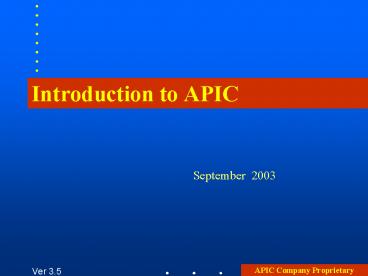Introduction to APIC - PowerPoint PPT Presentation
1 / 34
Title:
Introduction to APIC
Description:
Introduction to APIC September 2003 Technology and Product Areas HIP (Highly Integrated Phontonics) Chips System-on-a-chip - convergence of photonics and ... – PowerPoint PPT presentation
Number of Views:126
Avg rating:3.0/5.0
Title: Introduction to APIC
1
Introduction to APIC
- September 2003
2
Advanced Photonics Integrated Circuits Corporation
- Founded in September 1999
- Currently about 40 employees
- 80 with advanced technical and business degrees
- Two business locations
- Honolulu (10,000 sq ft) - Headquarter
processing - Culver City (26,000 sq ft) - Design center RD
3
APIC Culver City Building
4
APIC Honolulu Building
5
Technology and Product Areas
- HIP (Highly Integrated Phontonics) Chips
- System-on-a-chip - convergence of photonics and
electronics on one chip - Ultra-sensitive homeland defense sensors
- Multi-band translithic imager
6
Value Proposition
Integrate active and passive photonic devices
- Reduce footprint
- Reduce customers parts count
- Reduce losses associated with pigtailing
- Reduce customers costs
7
BUSINESS AREAS
- PIC components/optical modules for military and
commercial markets - Government Contracts
8
Key Business Milestones
- Intel Capital Investment May 2001
- ASML Development Agreement July 2002
- Silicon Genesis Development Agreement Sept
2002 - Intel Collaboration Agreement October 2002
- Applied Material Etching Support Jan 2003
- 1st Military contract (Sub to Lockheed-Martin) Mar
ch 2003
9
Current Government Contracts
Plus other smaller contracts for a total of 8.5M.
10
SOI Fabricated Wafer
11
EA-6B Jammer Application
12
E-2C Radar Applications
13
UAV Laser Communication
14
Photoacoustic Effect
Microphone
Laser In
Pressure Waves from laser absorption
15
Photoacoustic System
W0
Detection Cell
Modulated Current Driver
Laser
Modulated at natural resonant frequency of the
cell ??1
Each discrete wavelength is stepped through and
any addition of spectra is done at each step
before moving on. It takes 2-3 sec to scan laser
range dependent on actuator speed
l
Power Meter
r
Sample is held for integration period 1 10 sec.
Microphone
Coated Window
Lock-In Amplifier
Pump
Anti-reflective coating
Gas Exit
Gas Sample Inlet
Signal Output
16
Chemical Agents--VX and GB
CO2 Range
17
Carbon Nanotube Sensor
18
TIVISIT Multi-Band Imager
19
Our Product Categories
- Optical-electrical conversion
- Transmitters, detectors, transceivers
- Amplification
- EDWA, SOA
- DWDM (mux/demux)
- AWG, gratings, interlevers
- Optical switching
- MEMS, PZT fiber, thermo-optic electro-optical
switches - Optical signal control and management
- Dispersion, ICOM, VMUX
20
Optical Networking Food Chain
Proposed positionfor APIC
21
Technology Materials
- SOI Substrate
- Mature process reliable substrate
- Capitalize on standard, high-volume semiconductor
manufacturing processes - Inherently low polarization sensitivity
- Potential for integration of active
optoelectronic devices (including electronic
control circuits) - Ge and InGaAsP
- High yields for simple devices
22
Common Platform for Products
1. Mux/demux (AWG)
PICfoundation
2. Reconfigurable OADM Integrated mux VOA
4. Tunable WDMA Tx/Rx
3. Multi-channelreceivers
23
Fabricated SOI Chip
24
SOI Chip Output
25
Fabricated Thermo-Optic Switch
- On/Off switch
- Mach Zender-based
- 1x2 and 2x2 in development
26
Thermo-Optic Switch Response
30 µs cycle time(On -gt Off -gt On)
Optical output
Heater Bias
27
Tunable Receiver/Channel Equalizer on one chip
28
Integrated Ge detector with SOI waveguide
29
ProductMultiple Channel Receiver
Output Aperture
Input Aperture
Array of Detectors
PWR
PWR
Object Plane
Image Plane
TIAArray
CDR
Ge or InGaAs
Data
Input Waveguide
AWG Demux
- SOI Ge Photo Detector array Circuit
amplifiers Clock Recovery - Patented Germanium integrated Array Photo
Detectors - Prototype has been fabricated in the lab
Clock Data Recovery (CDR) Trans-Impedance
Amplifier(TIA)
30
Reconfigurable Optical ADM
Control Electronics
Array of 2x2Switches
Add
Drop
Elimination of 4 N interconnections (e.g. 160
for a 40-channel system)
31
Honolulu Cleanroom Facility
32
Culver City Cleanroom
33
Strategic Relationships
APIC
Defense Contractors
University Research
Wafer
Semiconductor
Optical Comms
Equipment Vendors
fabricator
fabricator
electronics
manufacturer
34
Summary - Capitalize on Advantages
- Skilled technical people
- Defense electronics
- University research
- Focus on materials handling and fabrication
- Benefits of SOI IC manufacturing technology
- Convergence of Photonics and Electronics on one
chip - System-on-a chip implementation
- Translithic and nano technolgy
- Ultra-sensitive chemical biological sensors

